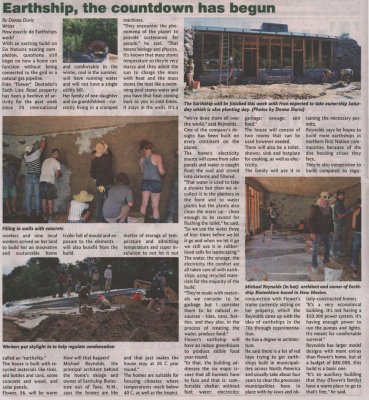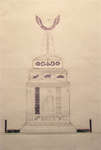"Earthship, the countdown has begun"
- Publication
- Turtle Island News, 27 Jul 2016
- Full Text
- Earthship, the countdown has begunBy Donna Duric, Writer
How exactly do Earthships work?
With an exciting build on Six Nations nearing completion, questions still linger on how a home can function without being connected to the grid or a natural gas pipeline.
Fran "Flower" Doxtador's Sixth Line Road property has been a beehive of activity for the past week since 70 international workers and nine local workers arrived on her land to build her an innovative and sustainable home called an "earthship."
The house is built with recycled materials like tires, old bottles and cans, some concrete and wood, and solar panels.
Flower, 56, will be warm and comfortable in the winter, cool in the summer, will have running water and will not have a single utility bill.
Her family of one daughter and six grandchildren - currently living in a cramped trailer full of mould and exposure to the elements - will also benefit from the build.
How will that happen?
Michael Reynolds, the principal architect behind the home's design and owner of Earthship Biotecture out of Taos, N. M., says the homes are like machines.
"They encounter the phenomena of the planet to provide sustenance for peoples," he said. "That means biology and physics. It's known that mass stores temperature so they're very massy and they admit the sun to charge the mass with heat and the mass stores heat like a swimming pool stores water and you have heating coming back to you in the cold times. It stays in the walls. It's a matter of storage of temperature and admitting temperature and super insulation to not let it out and that just makes the house stay at 20 C year round."
The homes are suitable for freezing climates where temperatures reach below 40 C, as well as the tropics.
"We've done them all over the world," said Reynolds. One of the company's designs has been built on every continent on the planet.
The home's electricity will come from solar panels and water is caught from the roof and stored into cisterns and filtered.
"That water is used to take a shower but then we recollect it in the planters in the front and to water plants but the plants also clean the water up - clean enough to be reused for flushing the toilet," he said. "So we use the water three of four times before we let it go and when we let it go we still use it in rubber-lined cells for landscaping."
The water, the sewage, the electricity, the comfort are all taken care of with earthships using recycled materials for the majority of the build.
"They're made with materials we consider to be garbage but I consider them to be natural resources - tires, cans, bottles, and they also, in the process of treating the water, produce food."
Flower's earthship will have an indoor greenhouse to produce edible food year-round.
"In that, the building addresses the six major issues that all humans have to face and that is: comfortable shelter without fuel; water; electricity; garbage; sewage; and food."
The house will consist of two rooms that can be used however needed.
There will also be a toilet, shower, sink and hotplate for cooking, as well as electricity.
The family will use it in conjunction with Flower's trailer currently sitting on her property, which the Reynolds came up with the idea of earthships in the 70s through experimentation.
He has a degree in architecture.
He said there is a lot of red tape trying to get earthships built in municipalities across North America and usually take about four years to clear the processes municipalities have in place with by-laws and obtaining necessary permits.
Reynolds says he hopes to build more earthships in northern First Nation communities because of the dire housing crises they face.
They're also inexpensive to build compared to regularly-constructed homes.
"It's a very economical building. It's not having a $50,000 power system. It's having enough power to run the pumps and lights. It's meant for comfortable survival."
Reynolds has larger model designs with more extras than Flower's home, but at a budget of $80,000, this build is a basic one.
"It's an auxiliary building that they (Flower's family) have a warm place to go to that's free," he said.
- Creator
- Duric, Donna, Author
- Media Type
- Text
- Newspaper
- Item Type
- Clippings
- Publisher
- Turtle Island News
- Place of Publication
- Six Nations of the Grand River, ON
- Date of Publication
- 27 Jul 2016
- Subject(s)
- Personal Name(s)
- Doxtador, Fran "Flower" ; Reynolds, Michael.
- Corporate Name(s)
- Earthship Biotecture.
- Local identifier
- SNPL005343v00d
- Language of Item
- English
- Geographic Coverage
-
-
Ontario, Canada
Latitude: 43.06681 Longitude: -80.11635
-
- Creative Commons licence
 [more details]
[more details]- Copyright Statement
- Public domain: Copyright has expired according to Canadian law. No restrictions on use.
- Copyright Date
- 2016
- Copyright Holder
- Turtle Island News
- Contact
- Six Nations Public LibraryEmail:info@snpl.ca
Website:
Agency street/mail address:1679 Chiefswood Rd
PO Box 149
Ohsweken, ON N0A 1M0
519-445-2954



